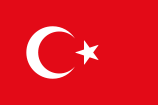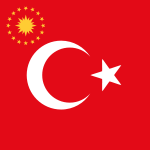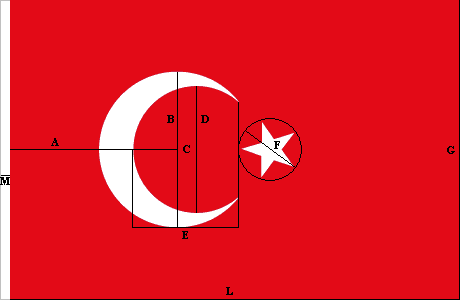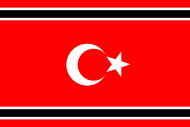Flag of Turkey
 |
|
| Use | National flag and ensign |
|---|---|
| Proportion | 2:3 |
| Adopted | 1844 |
| Design | A red field with a white crescent moon and five-pointed star slightly left of centre. |
The flag of Turkey (Turkish: Türk bayrağı) is a red flag with a white crescent moon and a star in its centre. The flag is called Ay Yıldız (literally, moon star.) or Albayrak (Red flag). Turkish flag called Alsancak (Red banner) in Turkish National Anthem.
The flag has a complex origin since it is an ancient design, and uses the same symbols of the late flag of the Ottoman Empire which were adopted in 1844 with the Tanzimat reforms; though the shape, placement and shade of the color vary. The geometric proportions of the flag were legally standardized with the Turkish Flag Law in 1936. The shade of red used in the flag is approximated by RGB (227, 10, 23).
Contents |
History

The current design of the Turkish flag is directly derived from the late Ottoman flag, which had acquired its final form in 1844. It is known that the Ottomans used red flags of triangular shape at least since 1383, which came to be rectangular over the course of history.
Ottomans used several different designs, most of them featuring one or more crescents, for different purposes, such as the flag with green background signifying the caliphate. During the late imperial period, the distinctive use of the color red for secular and green for religious institutions became an established practice. In 1844, the eight-pointed star was replaced with a five-pointed star and the flag reached the form of the present Turkish flag; Red was the colour of Umar I, the Caliph who ruled from AD 634 to 644 and was known as a great consolidator of the Islamic Empire. In the 14th century red became the colour of the Ottoman Empire. The Ottoman Flag's crescent moon was thicker than its current design.
The origin of the flag is the subject of various legends in the country, some contradicting the historical knowledge about the Ottoman Flag.
Possible origins
The Star and Crescent signifies concentration, openness and victory, as well as sovereignty and divinity. According to tradition, in 339 BC a brilliant waxing moon save Byzantium (now Istanbul) from attack by Philip of Macedonia. To mark their gratitude, the citizens adopted the Crescent of Diana as the city's emblem. When the city became the Christian Constantinople in 330 AD, its Crescent assumed the significance of an attribute of the Virgin Mary.
In 1299, conquering what is now Turkey, Sultan Osman had a vision of a crescent moon stretching over the world; it thus became a symbol of the Ottoman dynasty, and when Constantinople fell to Mehmed II in 1453, the crescent came to represent both Islam and the Ottoman empire. The star was added by Sultan Selim III in 1793 (its five points being established in 1844)
The crescent moon and star were holy symbols for pre-Islamic Turkish tribes, while red was the cardinal color for west in ancient Turkic culture. In Turkish tradition, red also represents hegemony, while white represents power, justice, exaltation and purity. Göktürks, a pre-Islamic Turkic people who lived in Central Asia, used crescent and star on their coins. A 1500 years old Göktürk coin includes three figures of a crescent moon and a star around the possible figure of a leader.[1][2]
Legends
The most accepted legend of the flag in Turkey is that in a pool of blood of Turkish warriors, there was a reflection of the crescent moon and a star. The two popular versions of this legend are:
- In the year 1071, after the Battle of Manzikert and the defeat of the Byzantine army, the Seljuk Khan, Alp Arslan was roaming the battlefield where he saw the reflection of the crescent moon and the star on a pool of blood of Turkish warriors. After he saw this image, he decided that this would be the flag representing the Turks.
- After the Battle of Kosovo on June 28, 1389, Murad I was assassinated and on that night there was a unique moment of Jupiter and the Moon next to each other. If one considers this sight on a pool of blood, the current structure of the Turkish flag can be seen easily. One problem with this theory is that the Battle of Kosovo actually took place over a month earlier - on the 15th of June in the Julian Calendar (23 June in the Proleptic Gregorian Calendar).
Other Turkish legends include:

- A dream of the first leader of Hunnic-Turk Alliance, Mete Khan in which a crescent and star appeared from his chest and expanded.
- A crescent and star were spotted on the night of the fall of Constantinople to Mehmed II in 1453.
Legal basis
Fundamentals of the Turkish flag were laid down by Turkish Flag Law No. 2994 on May 29, 1936. Turkish Flag Regulation No. 2/7175 dated July 28, 1937, and Supplementary Regulation No. 11604/2 dated July 29, 1939, were enacted to describe how the flag law would be implemented. The Turkish Flag Law No. 2893 dated September 22, 1983, and Published in the Official Gazette on September 24, 1983, was promulgated six months after its publication. According to Article 9 of Law No. 2893, a statute including the fundamentals of the implementation was also published.
Construction

| Letter | Measure | Length |
|---|---|---|
| G | Width | |
| A | Distance between the centre of the outer crescent and the seam of the white band | 1/2 G |
| B | Diameter of the outer circle of the crescent | 1/2 G |
| C | Distance between the centres of the inner and outer circles of the crescent | 1/16 G |
| D | Diameter of the inner circle of the crescent | 2/5 G |
| E | Distance between the inner circle of the crescent and the circle around the star | 1/3 G |
| F | Diameter of the circle around the star | 1/4 G |
| L | Length | 1 ½ G |
| M | Width of the white hem at the hoist | 1/30 G |
The above specification is what is given by Turkish Flag Law. Note that this implies that the distance between (the left edge of) the inner circle of the crescent and a vertical line connecting the two pointed ends of the crescent is 279/800 G = 0.34875 G; thus, the left point of the star protrudes with about 0.0154 G beyond that line.
A common mistake in rendering the flag is to omit the white hem at the hoist (the left side).
Similarity with the Aceh Independentist Flag

The flag used by the independence-seeking rebels in the Indonesian province of Aceh, who have conducted a decades-long struggle against both Dutch colonial rule and the post-1949 Indonesian government, bears an obvious resemblance to the flag of Turkey; presumably dating from the devoutly Muslim inhabitants of 16th century Aceh who declared allegiance to the Ottoman Sultan and Caliph Suleiman the Magnificent in 1566 and asked for his support against the encroaching Portuguese and Dutch, upon which the Ottoman Indian Ocean Fleet under Kurtoğlu Hızır Reis arrived at Aceh in 1569.[3]
Similarity with the Uyghur Independentist Flag
.svg.png)
The Uyghurs use a blue version of the flag. This flag is used by Uyghurs as a symbol of the East Turkestan independence movement. It is almost identical to the flag of Turkey except with a blue background.
Similarity with Other Flags
Flag of Turkish Republic of Northern Cyprus, flag of former Republic of Hatay, Turkmeneli flag or Iraqi Turkmens, etc.
See also
- Gallery of flags with crescents
Notes and references
- ↑ 1500 year old coin with crescent moon and star (Turkish)
- ↑ [Gaybullah Babayarov, "The Catalogue of the coins of Turkic Qaghanate", TIKA, 2007, p 91]
- ↑ "Bayrak yasağını Türk ay-yıldızıyla deldiler" (in Turkish). February 10, 2005. http://hurarsiv.hurriyet.com.tr/goster/ShowNew.aspx?id=295614.
External links
- Türk Bayrağı Kanunu, the Turkish text of the Turkish Flag Law No. 2893 dated September 22, 1983, establishing the proportions, production and rules of usage of the flag of Turkey
- Turkey at Flags of the World
|
||||||||||||||||||||||||||||||||||||||||||||||
|
|||||||||||||||||
|
||||||||||||||
|
||||||||
